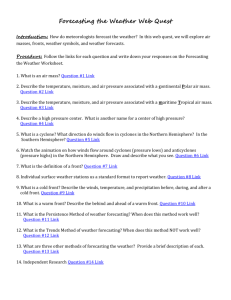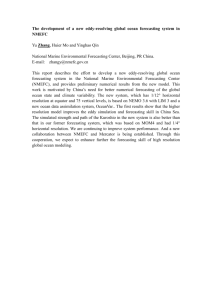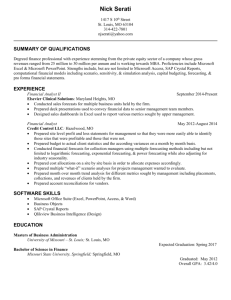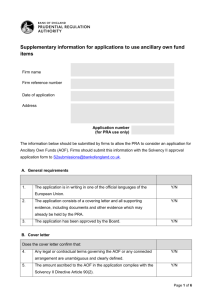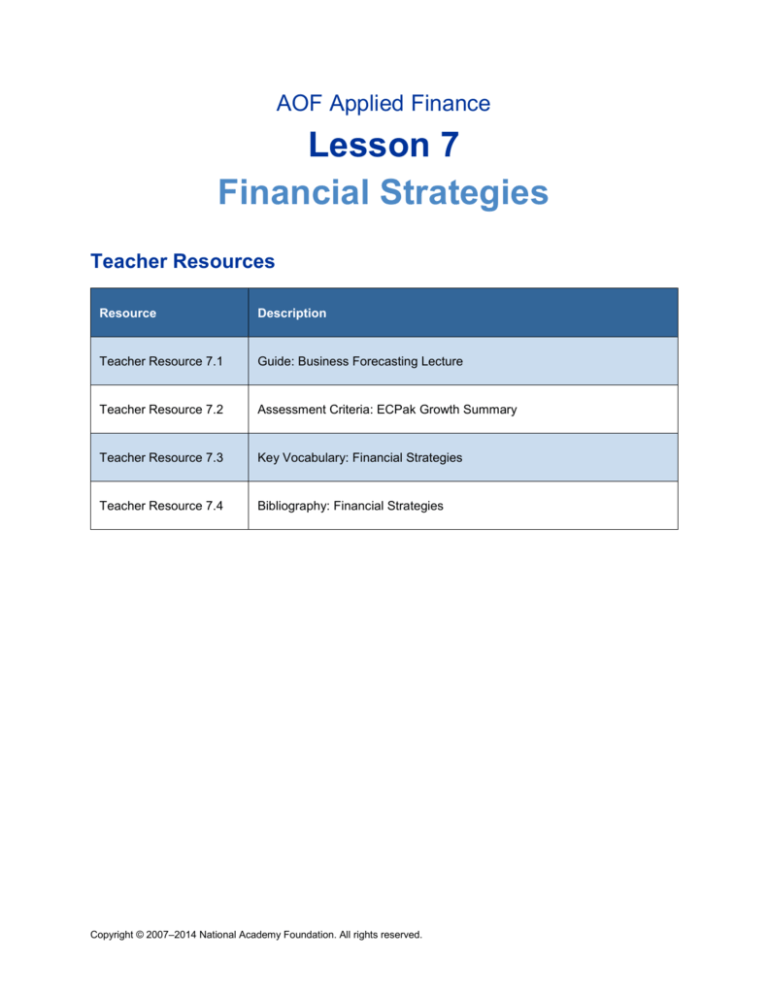
AOF Applied Finance
Lesson 7
Financial Strategies
Teacher Resources
Resource
Description
Teacher Resource 7.1
Guide: Business Forecasting Lecture
Teacher Resource 7.2
Assessment Criteria: ECPak Growth Summary
Teacher Resource 7.3
Key Vocabulary: Financial Strategies
Teacher Resource 7.4
Bibliography: Financial Strategies
Copyright © 2007–2014 National Academy Foundation. All rights reserved.
AOF Applied Finance
Lesson 7 Financial Strategies
Teacher Resource 7.1
Guide: Business Forecasting Lecture
1. Definition and purpose
a. The process of making extrapolations about the future based on past data is known as
forecasting.
b. Forecasting is used by businesses so that they can make forward-thinking decisions in
the present and develop strategic plans for the future.
2. Pros and cons of forecasting
a. Pros
i. Forecasting can inform decision-making.
ii. Quality of data is vital to quality of forecasting.
iii. Forecasting enables businesses to plan resource allocation.
b. Cons
i. It is impossible to predict the future with any certainty, so predictions must be
recognized as fallible.
ii. The past is not a guide to the future. Numerical trends can be helpful but are not
always definitive.
iii. Qualitative influences—human factors, peer pressure, and so forth—reduce the
reliability of business forecasting.
iv. Changes in business objectives can make forecasts superfluous.
v. External factors—major world events, acts of nature, and so on—cannot be
predicted with any certainty.
3. Methods
a. Quantitative
i. Quantitative methods are used when statistical data are available.
ii. Quantitative analysis involves tracking “moving averages” and looking for
trends, cyclical variations, seasonal variations, and so forth.
iii. Quantitative analysis involves extrapolation: taking data from the past and
projecting it into the future.
b. Qualitative
i. Qualitative methods assess opinion.
ii. Consumer panels, focus groups, and in-house judgments are common methods
of gathering data for qualitative analysis.
Adapted from biz/ed website. Available at
http://www.bized.co.uk/educators/16-19/business/strategy/presentation/forecasting_map.htm
Copyright © 2007–2014 National Academy Foundation. All rights reserved.
AOF Applied Finance
Lesson 7 Financial Strategies
Teacher Resource 7.2
Assessment Criteria: ECPak Growth Summary
Student Name:______________________________________________________________
Date:_______________________________________________________________________
Using the following criteria, assess whether the student met each one.
Met
Partially
Met
Didn’t
Meet
The summary includes an accurate overview of the
historical data presented.
□
□
□
The summary includes an accurate overview of what the
survey data claims.
□
□
□
The summary clearly explains what sort of growth in
profits ECPak should expect. The reasoning is supported
with specific examples from the data.
□
□
□
The concluding statement includes a realistic prediction of
where ECPak is headed in the next three to five years.
□
□
□
The summary is neat, legible, and presentable and uses
proper spelling, grammar, and punctuation.
□
□
□
Additional Comments:
_____________________________________________________________________________
_____________________________________________________________________________
_____________________________________________________________________________
_____________________________________________________________________________
Copyright © 2007–2014 National Academy Foundation. All rights reserved.
AOF Applied Finance
Lesson 7 Financial Strategies
Teacher Resource 7.3
Key Vocabulary: Financial Strategies
Term
Definition
budgeting
Establishing a planned level of revenue and spending for a given time
period.
cash budget
A planned level of cash income and spending for a given time period.
external factors
Opportunities, risks, and threats that are outside of an organization’s
control. Political, environmental, technological, and social factors are all
considered external factors.
extrapolation
To estimate for the future based on current data.
forecasting
The process of making extrapolations about the future based on past
data.
irregular expenses
Expenses that are not paid regularly each month. Also referred to as
unexpected expenses.
manage
The process of allocating a firm’s resources to maximize value.
measure
The process of assessing a firm’s resources and value.
operating budget
A projection of income and expenses based on a forecasted sales
revenue for a given time period.
qualitative analysis
An analysis based on subjective judgment that is not quantifiable, such
as management expertise, labor relations, and so forth.
quantitative analysis
A mathematical analysis based on understanding the reasoning of a
given event or behavior.
resource allocation
The process of allocating money to a specific project, business unit, or
cause. A way to assign the available resource in a very specific and
economic way.
Copyright © 2007–2014 National Academy Foundation. All rights reserved.
AOF Applied Finance
Lesson 7 Financial Strategies
Teacher Resource 7.4
Bibliography: Financial Strategies
The following sources were used in the preparation of this lesson and may be useful for your reference or
as classroom resources. We check and update the URLs annually to ensure that they continue to be
useful.
Print
Besley, Scott and Eugene Brigham. Principles of Finance. Mason, OH: Thomson South-Western, 2006.
Online
“Financial Services - Budgets & Reporting: Terms & Definitions.” Duke University,
www.finsvc.duke.edu/budget/budterm.html (accessed August 31, 2013).
“How to set a budget and stick to it.” BetterMoneyHabits.com,
http://www.bettermoneyhabits.com/en/videos/set-budget-stick-to-it.html?cat=savingbudgeting&incomplete#fbid=2TVMA7wHaPB (accessed November 21, 2013).
Copyright © 2007–2014 National Academy Foundation. All rights reserved.





